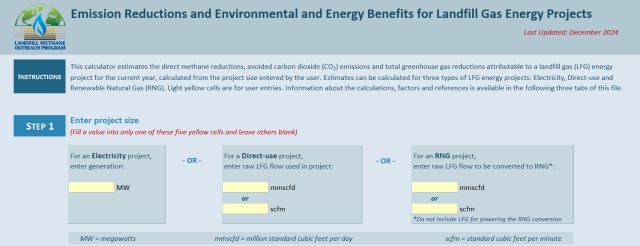Landfill Gas Energy Benefits Calculator
On this page:
Purpose
The LFG Energy Benefits Calculator can be used to estimate direct methane emission reductions and avoided carbon dioxide emissions, as well as environmental and energy benefit equivalencies, for a landfill gas (LFG) energy project. As noted in the ‘ReadMe’ tab in the Calculator, this tool does not perform a life cycle analysis for an LFG energy project’s emission reductions or emissions impact.
Direct Reductions
For all LFG energy projects, direct reductions are achieved by capturing and combusting landfill methane at landfills. This calculation of direct reductions is intended for landfills that are not already required by regulation to collect and combust LFG.
Avoided Emissions
LFG energy projects can also reduce greenhouse gas emissions by reducing the emission effects from consumption of fossil fuels for energy: electricity generation projects generally displace CO2 generated from fossil fuels burned at conventional power plants; direct-use projects typically displace fossil fuels used in local combustion equipment; and renewable natural gas projects displace either fossil natural gas (in pipelines or vehicles) or diesel fuel that is used as transportation fuel.
What's New
In 2024, LMOP revised the Calculator by:
- Adding input options, calculations and references specific to RNG projects, which were not previously included in the tool.
- Users can now enter site-specific data for a potential or existing RNG project (i.e., LFG flow, whether RNG is injected into a natural gas pipeline (for transportation fuel or another use) or used locally for vehicle fuel).
- Input options also include the technology's methane recovery rate and if grid electricity will power the RNG conversion.
- Including a ‘ReadMe’ tab to provide information about the tool’s purpose and scope.
- Reformatting all tabs in the Calculator for a more user-friendly experience.
Example Equivalency Results
The Calculator expresses methane emission reductions and avoided CO2 emissions in terms of environmental and energy benefit equivalencies, as shown in the following examples.
Estimated Total Environmental and Energy Benefits for Example LFG Energy Projects Using 2024 Calculator
| Typical 3-MW Electricity Projecta | Typical 1,000-scfm Direct-use Project | Typical 2,800-scfm RNG Projectb | |
|---|---|---|---|
| Environmental Equivalencies | |||
| Carbon sequestered by ______ acres of U.S. forests in one year | about 168,000 | more than 155,000 | about 440,000 |
| CO2 emissions from ______ railcars’ worth of coal burned | more than 920 | -- | -- |
| CO2 emissions from _______ barrels of oil consumed | -- | nearly 356,000 | about 1.0 million |
| CO2 emissions from _______ gallons of gasoline consumed | more than 18.7 million | about 17.3 million | -- |
| CO2 emissions from _______ gallons of diesel consumed | -- | -- | nearly 42.8 million |
| Energy Equivalencies | |||
| Powering _____ homes | more than 1,900 | -- | -- |
| Heating _____ homes | -- | more than 4,000 | -- |
MW = megawatt scfm = standard cubic feet per minute
a Results when using the national average avoided CO2 emission factor.
b Results when making these selections for project: RNG injected into natural gas pipeline for use as vehicle fuel, uses 100 percent grid electricity for the RNG upgrading process (with national average avoided CO2 emission factor) and has a 90 percent methane recovery rate.
Download the Calculator

Download the 2024 LFG Energy Benefits Calculator (xlsx)
Excel files can be viewed with the Free Microsoft Excel Viewer.
Annual Updates and Data Sources
Annually, LMOP updates the Calculator to reflect the most current factors available:
- Regional and national CO2 emission factors for the electric grid from EPA’s AVoided Emissions and geneRation Tool (AVERT).
- Average household energy consumption data from the Energy Information Administration’s Residential Energy Consumption Survey.
- Environmental equivalencies from the Greenhouse Gas Equivalencies Calculator on EPA’s Energy and the Environment website.
